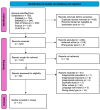NT-proBNP and BNP as Biomarkers for Preeclampsia: A Systematic Review and Meta-Analysis
- PMID: 40650050
- PMCID: PMC12250389
- DOI: 10.3390/ijms26136272
NT-proBNP and BNP as Biomarkers for Preeclampsia: A Systematic Review and Meta-Analysis
Abstract
The aim of this study was to evaluate and synthesize the existing evidence on N-terminal pro-brain natriuretic peptide (NT-proBNP) and brain natriuretic peptide (BNP) as biomarkers for preeclampsia as compared with a healthy pregnant group, but also comparing them in early-onset preeclampsia (EOP) versus late-onset preeclampsia (LOP). Five electronic databases, PubMed, EMBASE, Web of Science, Scopus, and LILACS, were searched for studies on pregnant women comparing NT-proBNP and BNP levels in preeclampsia vs. healthy pregnancies and EOP vs. LOP. From the 752 identified records, 31 studies were included in the review, referring to 3915 participants. When comparing PE to healthy pregnancies and EOP to LOP, there was a considerable increase in NT-proBNP levels in the PE group, respectively, in EOP: 206.19 pg/mL (95% CI 139.68-272.69) (p ≤ 0.001) in the PE group, and 182.42 pg/mL (95% CI 99.65-265.19) (p ≤ 0.001) in the EOP group. Regarding BNP, the levels were higher in the PE group (30.13 (95% CI 17.22-43.04), p ≤ 0.001), respectively in the EOP group (33.35 pg/mL (95% CI 20.26-46.43), p ≤ 0.001). NT-proBNP and BNP levels are consistently elevated in preeclampsia compared to healthy pregnancies and in EOP compared to LOP.
Keywords: biomarkers; brain natriuretic peptide; preeclampsia.
Conflict of interest statement
The authors declare no conflicts of interest.
Figures





References
Publication types
MeSH terms
Substances
LinkOut - more resources
Full Text Sources
Research Materials

